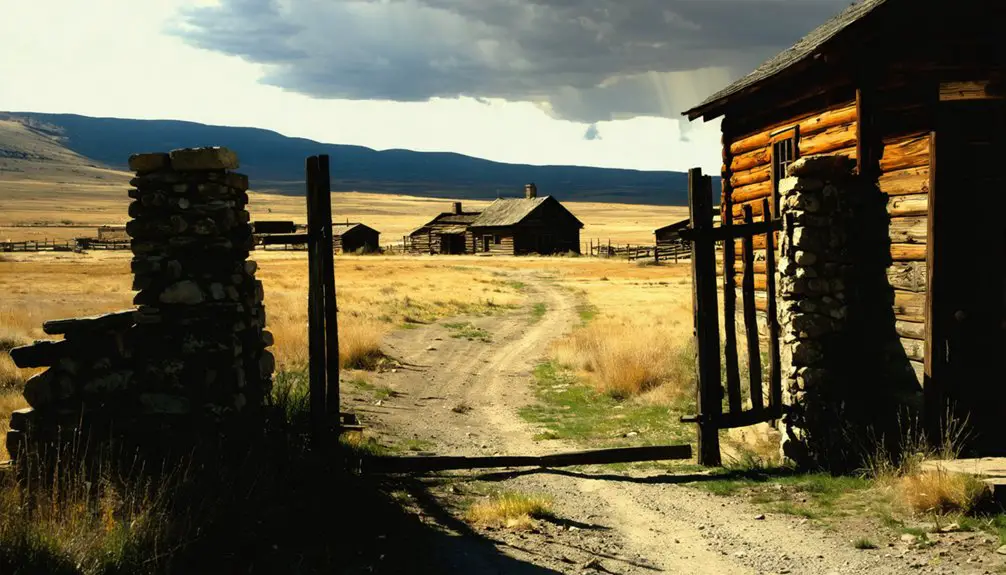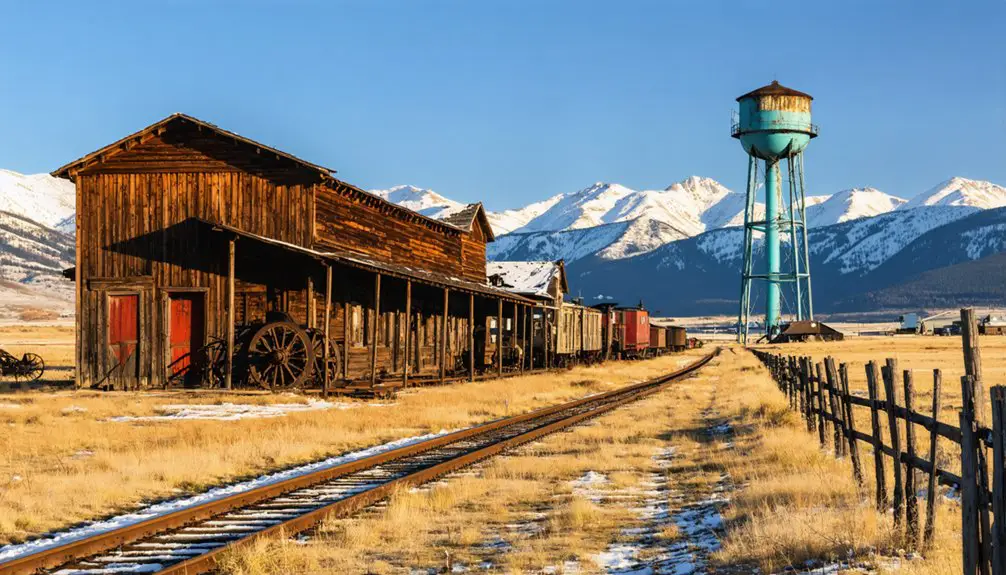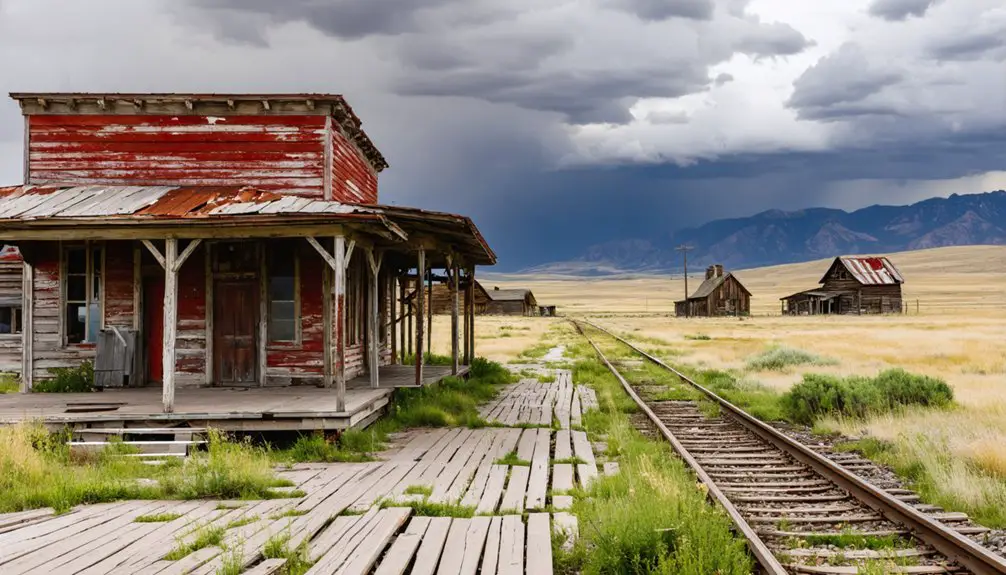You’ll find Fort Steele’s ghost town ruins in Carbon County, Wyoming, where it once protected Union Pacific Railroad workers in 1868. Named after Major General Frederick Steele, this military outpost housed 300 soldiers and evolved into an essential railroad hub before becoming a bustling stop along the Lincoln Highway in 1922. Today, you can explore the powder magazine and building foundations that tell a rich story of Wyoming’s frontier military and transportation heritage.
Key Takeaways
- Fort Steele became a ghost town after Interstate 80’s construction in 1939 bypassed the community, ending its role as a transportation hub.
- Originally established in 1868 as a military fort protecting Union Pacific Railroad workers, it later transitioned into a civilian settlement.
- The site features a preserved powder magazine and visible ruins of military buildings, offering glimpses into Wyoming’s frontier history.
- After military abandonment in 1886, Fort Steele thrived as a wool industry center and Lincoln Highway stop until economic decline.
- Archaeological remains include building foundations, stove remnants, and a cemetery, now protected for historical preservation since 1973.
The Birth of a Military Outpost
When the Union Pacific Railroad began its ambitious westward expansion in 1868, the U.S. Army established Fort Fred Steele as a crucial military strategy to protect construction workers from Native American attacks.
You’ll find the fort’s strategic location on the North Platte River’s west bank, carefully chosen by Colonel Richard I. Dodge.
What started as a tent city quickly evolved into a permanent installation under the command of its namesake, Major General Frederick Steele.
The fort’s 300 troops didn’t just guard the essential railroad bridge – they also responded to labor disputes throughout the region.
Local materials and skilled civilian workers, from blacksmiths to sawmill engineers, transformed the outpost into a proper military installation. The fort became a major shipping point for lumber and other materials needed for railroad construction. The bustling fort attracted merchants and settlers, forming a small but vibrant community around the military post.
Through the craftsmanship of local laborers and materials, this frontier outpost evolved from basic beginnings into a formidable military stronghold.
The soldiers’ presence helped secure the railroad’s progress while creating a foothold for settlement in Wyoming Territory.
Life on the Frontier Railroad
You’d find Fort Steele bustling with 300 soldiers guarding railroad operations while protecting crews from Native American attacks along the North Platte River crossing.
Life in this frontier outpost centered around the constant flow of lumber, ties, and commercial goods through its position as an essential transportation hub between the eastern and western territories.
Your daily routines would have included watching trains pass while dodging sparks that frequently threatened the wooden structures, as merchants, tie hacks, and railroad workers transformed this once-barren landscape into a thriving community.
Daily Railroad Protection Operations
Life along the frontier railroad demanded constant vigilance from the soldiers stationed at Fort Fred Steele.
You’d find these troops conducting daily railroad security operations, patrolling the tracks and watching over the crucial North Platte River bridge. Their duties included escorting supply trains and protecting workers from Native American attacks that threatened construction progress.
The fort’s 300 soldiers maintained round-the-clock guard shifts at strategic points, including warehouses and the powder magazine.
They’d spring into action to handle emergencies, from labor unrest to fire hazards caused by passing steam engines.
Patrol operations extended beyond just protecting the railroad – they safeguarded nearby settlers and maintained a watchful eye over the surrounding wilderness, ensuring the frontier’s essential transportation lifeline remained secure. The troops were also dispatched to manage the tensions that led to the tragic Chinese Massacre incident in Rock Springs.
Frontier Town Living Conditions
The rugged frontier settlement of Fort Steele offered stark living conditions that shaped daily existence for its military and civilian inhabitants. You’d have found yourself living in simple wooden structures, with soldiers bunking in basic barracks while officers enjoyed slightly better accommodations.
The frontier hardships were evident in the communal living arrangements, where you’d share facilities and rely on military provisions for basic needs. To supplement your lifestyle, you’d trade with the fort’s sutler for fresh produce and mercantile goods.
The settlement’s economy revolved around essential services like blacksmithing, logging, and sheep shearing. While the railroad brought some modern conveniences, life remained modest. Your survival depended on the interdependence between military personnel and civilian workers who kept the frontier outpost functioning.
Transportation Hub Activities
Fort Steele’s bustling railroad hub transformed a remote military outpost into an essential transportation nexus during the late 1860s.
You’d find about 300 soldiers coordinating logistical operations while protecting Union Pacific crews at this strategic North Platte River crossing.
The fort’s freight transportation activities connected multiple industries. You could watch lumber and railroad ties floating downriver to the fort’s storage yards, while livestock from local ranchers awaited shipment on the transcontinental line.
The site buzzed with civilian workers – blacksmiths, sawmill engineers, and wheelwrights – supporting both military and commercial needs.
Even after the fort’s military closure in 1886, the location remained critical to regional commerce, with the 1920s Lincoln Highway cutting through the old grounds, cementing Fort Steele’s legacy as a transportation cornerstone.
Building a Fortress in the Wyoming Territory
If you’d visited Fort Fred Steele in its earliest days of 1868, you’d have found a tent city quickly evolving into a permanent military installation built to Army specifications.
Using timber floated down the North Platte River and wood harvested from nearby Elk Mountain, some 300 troops and civilian laborers constructed everything from barracks and warehouses to specialized workshops and a powder magazine.
The fort’s development centered around a sawmill operated by Coe and Carbon, which supplied essential lumber for the growing fortress until 1886.
From Tents to Stone
During the sweltering summer of 1868, an ambitious military endeavor began on the west bank of North Platte River, where Colonel Richard I. Dodge selected the site for Fort Steele.
You’d have seen a tent city spring up first, housing 300 soldiers and civilian workers as they tackled the fort’s construction. The military architecture quickly evolved as the Quartermaster replaced canvas with permanent structures built to Army specifications.
Local resources drove the frontier economy, with lumber harvested from Elk Mountain and processed at the fort’s sawmill.
You’d have found a bustling complex of specialized buildings: barracks, officers’ quarters, warehouses, and a powder magazine. The fort was named after Civil War hero General Frederick Steele.
Skilled workers – blacksmiths, wheelwrights, and sutlers – kept the fort running while protecting Union Pacific Railroad workers from Indian attacks.
Local Materials Shape Design
While tents initially dotted the landscape, Fort Fred Steele‘s permanent structures emerged through a strategic blend of local materials from Wyoming Territory.
You’ll find evidence of local craftsmanship in the stone quarried nearby, expertly combined with timber harvested from Elk Mountain. This resource sustainability approach helped the fort withstand frontier conditions while reducing dependence on distant supplies.
The construction effort united military and civilian workers, with 300 troops earning extra pay alongside skilled craftsmen like blacksmiths and sawmill engineers.
Though the fort relied on some rail-delivered hardware and finished lumber from Omaha, its design primarily showcased Wyoming’s natural resources. The structures featured boards-and-battens or clapboards as exterior covering materials.
The masterful integration of stone and timber created buildings that could endure harsh climate extremes while serving as a defensive outpost until 1886.
Military Construction Work Pays
As the Union Pacific Railroad pushed westward in 1868, Fort Fred Steele’s construction offered lucrative opportunities for both military personnel and civilian workers.
You’d find military wages were particularly attractive, with troops receiving extra pay for their construction labor beyond regular duties.
Here’s what you needed to participate in the fort’s construction boom:
- Experience as a sawmill worker at nearby Coe and Carbon operations
- Skills in military quartermaster construction following Army specifications
- Ability to work alongside 300 fellow laborers, both military and civilian
- Willingness to build everything from barracks to powder magazines
The construction incentives proved worthwhile, transforming a tent city into a permanent military installation while stimulating the local economy through steady employment and increased demand for building materials. The strategic location at the North Platte River crossing made the fort’s development essential for protecting railroad operations.
Notable Conflicts and Military Operations
From its establishment in 1868, Fort Steele became the stage for significant military conflicts, particularly those involving Native American resistance to westward expansion.
You’ll find the fort’s most notable military operation occurred in 1879 when Major Thomas T. Thornburgh led troops to address Ute unrest in northern Colorado. This indigenous resistance culminated in the tragic Meeker Massacre, where Ute warriors killed Indian agent Nathan C. Meeker and nine others at the White River Indian Agency.
The military strategy proved costly when Thornburgh’s company was ambushed near the reservation’s edge, resulting in his death and the loss of 13 soldiers. The subsequent Battle of Milk Creek saw U.S. forces ultimately suppress the Ute rebellion within a week, marking a pivotal moment in the fort’s military history.
The Legacy of Major General Frederick Steele

You’ll recognize Major General Frederick Steele as both a distinguished Civil War commander and the fort’s honored namesake.
Steele’s remarkable combat record included his promotion to major general in 1862 and successful leadership of Union forces in capturing Little Rock, Arkansas. After being promoted to brigadier general, he commanded a division under Major General Samuel Curtis in the Army of the Southwest.
Prior to his Civil War service, he demonstrated valor during the Mexican-American War where he earned recognition for his bravery.
The fort received its name in 1868 shortly after Steele’s death, when Colonel Richard I Dodge selected the site to commemorate the general’s significant military contributions and frontier service.
Civil War Combat Record
Major General Frederick Steele’s Civil War combat record showcased both tactical successes and strategic challenges throughout his service.
His military tactics evolved from leading smaller units at Wilson’s Creek to commanding large-scale operations during the Vicksburg Campaign.
You’ll find his command strategies particularly evident in these major accomplishments:
- Demonstrated exceptional leadership during the Vicksburg Campaign, earning a promotion to major general while directing troops under Sherman.
- Successfully captured Little Rock in 1863, consolidating Union control in Arkansas.
- Led complex defensive maneuvers during the Camden Expedition, saving his forces from encirclement despite supply challenges.
- Commanded a division in the Mobile campaign of 1865, contributing to one of the final Union victories.
At Vicksburg, his division suffered significant casualties with over 300 casualties during the failed May 22 assault against Confederate defenses.
His early military experience in the Mexican War proved valuable in developing his combat leadership abilities.
These engagements reflect Steele’s growth from a West Point graduate to a seasoned combat commander.
Fort’s Namesake Origins
The legacy of General Frederick Steele lives on through Fort Steele, Wyoming, a military outpost that honored his distinguished service spanning multiple American conflicts.
You’ll find his military legacy woven into the American West’s fabric, beginning with his 1843 graduation from West Point and extending through his service in the Mexican-American War, Yuma War, and Civil War.
Steele’s historical significance stems from his remarkable rise through military ranks, advancing from first lieutenant in 1848 to captain by 1855, before achieving his most notable role as a Union general.
His strategic prowess in Arkansas, particularly during the capture of Little Rock and the challenging Camden Expedition, exemplified his tactical abilities.
Though he never married or had children, his name endures through this western fort, commemorating his contributions to America’s military history.
From Military Base to Wool Industry Hub
Established on June 20, 1868, Fort Fred Steele emerged as an important U.S. Army post protecting Union Pacific Railroad workers before evolving into a significant wool production hub.
After the military’s departure in 1886, you’ll find the fort’s economic shift reflected in four key developments:
- Former military buildings were sold and repurposed for civilian use in 1892-1893.
- The site became a key shipping point for Wyoming’s expanding wool industry.
- Local sheepherders utilized the area for grazing and wool transportation.
- Timber harvested from nearby Elk Mountain supported wool shipping infrastructure.
The fort’s strategic location and existing warehouses proved perfect for wool storage and distribution, while the railroad connection enabled efficient transport of agricultural products, cementing the region’s role in Wyoming’s livestock economy.
Transportation Gateway of the American West

Strategically positioned where the Union Pacific Railroad crossed the North Platte River, Fort Fred Steele emerged as an essential transportation nexus in America’s westward expansion.
Fort Fred Steele’s location at the railroad-river crossing made it a vital hub for America’s push toward the western frontier.
You’ll discover how this military outpost protected railroad construction while facilitating the flow of crucial supplies, especially timber floated downstream for railroad ties and lumber.
As you explore this ghost town’s transportation evolution, you’ll find evidence of its transformation from a military-railroad hub to a critical shipping point for the region’s booming sheep industry.
The 1922 addition of the Lincoln Highway brought automobile pioneers through Fort Steele, adding another layer to its transportation legacy.
Though the 1939 rerouting of U.S. 30 diminished its prominence, the site’s historic role in connecting rail, river, and road transport shaped Wyoming’s development.
The Lincoln Highway Years
When America’s first transcontinental highway reached Fort Steele in 1922, it brought a welcome economic revival to this former military outpost.
You’ll find evidence of how the Lincoln Highway transformed the site’s old military buildings into a bustling roadside community. The fort’s structures found new life serving highway travelers:
- Former barracks became a 22-room hotel until fire claimed it in 1923
- Military buildings were converted into gas stations and cafes
- Local timber and sheep industries continued alongside traveler services
- Original structures served as motels and roadside stops
This renaissance wouldn’t last forever.
In 1939, the highway’s rerouting to today’s I-80 corridor spelled doom for Fort Steele’s revival. Combined with the railroad tie industry’s collapse in 1940, the site gradually transformed into the ghost town you’ll explore today.
Surviving Structures and Archaeological Remains
Among Fort Steele’s numerous original structures, only the powder magazine stands fully intact today, offering visitors a rare glimpse into the fort’s military past.
You’ll find remnants of two large warehouses and partial officer’s quarters that showcase the original layout, while visible foundations mark where barracks and other buildings once stood.
The site’s archaeological significance lies in its well-preserved ruins, including distinctive stove remains and cemetery features.
While fires from passing locomotives and natural deterioration claimed most wooden structures, you can still explore the clustered building foundations that reveal the fort’s defensive design.
Since 1973, ruin preservation efforts at Fort Fred Steele State Historic Site have focused on protecting these remaining structures, with interpretive trails helping you discover Wyoming’s frontier military heritage.
Preserving Wyoming’s Railroad Heritage
Through coordinated preservation efforts across Wyoming, organizations like Tracks Across Wyoming and the Alliance for Historic Wyoming safeguard the state’s rich railroad heritage. These initiatives promote heritage tourism while protecting historic transportation corridors for future generations.
You’ll find Wyoming’s railroad preservation efforts highlighted through:
- Free public access to museums like the Laramie Historic Railroad Depot, showcasing Union Pacific artifacts
- Adaptive reuse projects, such as Evanston’s transformed Union Pacific Roundhouse Complex
- Educational programs featuring audio tours and exhibits about railroad operations and technology
- Detailed documentation of historic sites like the Medicine Bow Depot, supporting National Register nominations
These preservation efforts balance modern community needs with historical integrity, ensuring you can experience Wyoming’s authentic railroad heritage through carefully maintained structures and educational resources.
Frequently Asked Questions
What Was the Daily Life Like for Women and Children at Fort Steele?
You’d spend your days tending to domestic duties like cooking, cleaning, and childcare, while making time for community events to maintain social bonds despite frontier challenges.
How Much Did Soldiers Get Paid for Their Extra Construction Work?
You’d think we’d know exactly what soldiers earned for construction work, but ironically, there’s no documented specific wage – though their regular pay ranged from $1,249 to $2,544 annually plus possible allowances.
Were There Any Famous Outlaws or Bandits Associated With Fort Steele?
While you’ll hear outlaw legends of Butch Cassidy’s Wild Bunch passing through the region, there aren’t any bandit stories specifically tied to Fort Steele beyond general Wyoming frontier lawlessness.
What Native American Tribes Lived in the Area Before the Fort’s Establishment?
You’d find fierce tribes roaming these untamed plains – the proud Arapaho maintained hunting grounds here, while Shoshone culture flourished alongside Cheyenne bands. The Lakota Sioux also traversed these ancestral lands.
Did Any Epidemics or Major Diseases Affect the Fort’s Population?
You won’t find specific records of epidemic outbreaks at the fort, but Wyoming’s 1918 Spanish flu and trail-era cholera likely impacted the area, given the disease’s widespread regional impact.
References
- http://www.wyomingtalesandtrails.com/lincoln3.html
- https://www.legendsofamerica.com/wy-fortfredsteele/
- http://www.wyomingcarboncounty.com/images/museums/fred_steele.pdf
- https://www.wyohistory.org/encyclopedia/fort-fred-steele
- https://www.tripadvisor.com/Attraction_Review-g60555-d292673-Reviews-Fort_Fred_Steele_State_Historic_Site-Sinclair_Wyoming.html
- https://wyoparks.wyo.gov/index.php/cat-list-sphst/74-historic-sites/fort-fred-steele-state-historic-site
- https://historicwyoming.org/profiles/onwardtofortsteele/
- https://www.americanheritage.com/content/fort-fred-steele
- https://wyoshpo.wyo.gov/index.php/programs/national-register/wyoming-listings/view-full-list/434-fort-fred-steele
- https://www.youtube.com/shorts/b-MpTiVspwk



